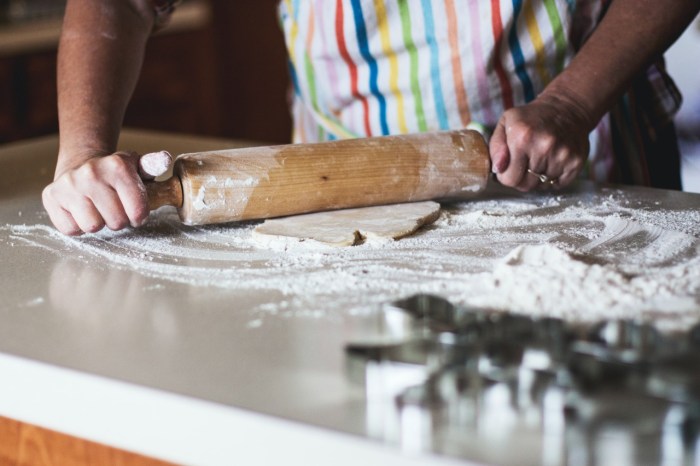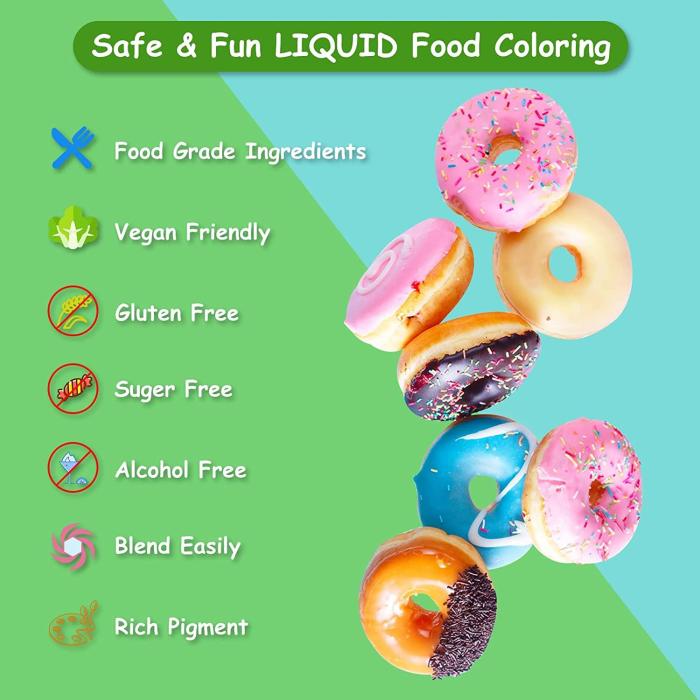All Natural Food Coloring for Baking
Creating Color Palettes with Natural Ingredients

All natural food coloring for baking – The pursuit of vibrant and naturally derived colors in baking presents a delightful challenge, offering a palette far richer and more nuanced than artificial food colorings. This exploration delves into the art of crafting diverse color schemes using readily available natural ingredients, transforming simple baked goods into edible works of art. The inherent limitations of natural colorings—their subtle variations and often delicate hues—become opportunities for creativity, demanding a nuanced approach to color blending and intensity.
Achieving a desired shade often involves a delicate balance of ingredients and precise measurements. Understanding the individual properties of each coloring agent is paramount. For instance, the intensity of a beetroot hue can vary dramatically depending on the variety and its cooking method. Similarly, turmeric’s yellow can be muted by the addition of other ingredients, while spirulina’s deep blue can be surprisingly versatile in creating both vibrant blues and muted greens.
Recipe Demonstrations of Color Combinations, All natural food coloring for baking
This section presents a series of baking recipes illustrating the versatility of natural food colorings. Each recipe highlights specific color combinations and their corresponding natural sources.
Recipe 1: Sunshine Citrus Cake. This cake features a vibrant sunshine yellow achieved with turmeric powder (1 tsp) and a touch of saffron threads (a pinch) for depth. The batter is further enhanced with the zest of oranges and lemons, lending a bright citrusy aroma that complements the sunny hue. The final product boasts a pale, yet luminous yellow, reminiscent of a summer’s day.
Recipe 2: Crimson Raspberry Swirl Brownies. These brownies showcase a rich, deep burgundy, primarily from reduced raspberry puree (½ cup) simmered to intensify its color. A small amount of cocoa powder (1 tbsp) adds complexity and deepens the overall tone. The final product is a beautiful marbled effect, with the crimson swirls contrasting elegantly against the dark chocolate base.
Recipe 3: Emerald Matcha Madeleines. These delicate cookies display a soft, spring-like emerald green, resulting from the incorporation of matcha powder (2 tbsp). A hint of spinach puree (1 tbsp) subtly enhances the green hue and adds a touch of earthy flavor. The final product is a gentle, pastel green, reminiscent of fresh spring foliage.
Chart of Natural Food Coloring Combinations
The following chart illustrates how various shades and intensities can be achieved by combining different natural colorings. Understanding the interplay between these ingredients allows for a greater degree of control over the final color. It’s important to note that results may vary depending on the specific ingredients used and their quality.
Achieving rich, earthy tones in your baked goods using all-natural food coloring can be surprisingly simple. For instance, if you’re aiming for a deep brown, understanding the color combinations is key; you might find yourself needing to check out a helpful guide like this one on what colors make brown with food coloring to achieve the perfect shade.
Once you master the color mixing, you can create stunning naturally-colored cakes and cookies, free from artificial additives.
| Desired Shade | Primary Coloring Agent | Secondary Coloring Agent (Optional) | Resulting Hue |
|---|---|---|---|
| Light Yellow | Turmeric | Lemon Juice | Pale, sunny yellow |
| Deep Orange | Turmeric | Carrot Puree | Rich, vibrant orange |
| Muted Pink | Beetroot | Lemon Juice (to balance intensity) | Soft, delicate pink |
| Deep Burgundy | Beetroot | Cocoa Powder | Rich, dark burgundy |
| Vibrant Green | Spinach Puree | Matcha Powder | Bright, intense green |
| Muted Green | Kale Puree | None | Soft, earthy green |
Visual Representations of Color Palettes
The visual descriptions below aim to capture the essence of the color palettes achievable with these natural ingredients. These are not exhaustive, but rather illustrative of the possibilities.
Palette 1: Sunshine Citrus. This palette evokes warmth and brightness, featuring a range of yellows, from a pale, almost creamy yellow to a richer, deeper gold, achieved through variations in turmeric concentration and the addition of saffron or citrus zest.
Palette 2: Berry Bliss. This palette explores the spectrum of reds and purples, ranging from a delicate rose pink, created with a small amount of beetroot, to a deep, almost blackcurrant purple, achieved by combining beetroot with blackberry puree.
Palette 3: Earthy Greens. This palette captures the natural variations in green, from a soft, pastel green reminiscent of spring leaves, achieved with matcha, to a more intense, forest green, created by combining spinach and kale purees.
Impact of Natural Food Coloring on Baking Properties: All Natural Food Coloring For Baking

The transition from artificial to natural food colorings in baking presents a fascinating interplay between aesthetics and functionality. While the vibrant hues of artificial colors are undeniably appealing, their synthetic nature raises concerns about health and environmental impact. Natural alternatives, derived from plants, fruits, and vegetables, offer a healthier and more sustainable approach, but their incorporation into baking recipes necessitates a nuanced understanding of their impact on the final product’s properties.The inherent characteristics of natural food colorings significantly influence the texture, taste, and overall quality of baked goods.
Unlike their artificial counterparts, which often possess neutral flavor profiles and minimal textural impact, natural colorants introduce their own unique flavor nuances and can affect the moisture content and density of the baked product. This interaction necessitates careful consideration and, in many cases, recipe adjustments.
Textural Modifications
Natural food colorings, owing to their varying compositions, can subtly alter the texture of baked goods. For instance, using beetroot juice for a red velvet cake might slightly increase the moisture content, potentially leading to a denser crumb. Conversely, using turmeric powder, which absorbs moisture, could result in a drier texture if not properly accounted for in the recipe.
A baker might need to adjust the liquid content or add additional binding agents like eggs or cornstarch to compensate for these textural shifts, achieving the desired outcome. The specific impact will depend heavily on the type and concentration of the natural colorant employed and the recipe itself.
Flavor Profile Alterations
The incorporation of natural food colorings inevitably introduces subtle flavor changes. While some, like carrot puree for orange hues, add a pleasant sweetness, others might impart more pronounced flavors that could clash with the overall taste profile of the baked good. For example, using spinach to achieve a green color might introduce a slightly earthy or grassy note. A skillful baker anticipates these flavor nuances and employs techniques like balancing them with complementary ingredients (e.g., adding citrus zest to counteract earthiness) or adjusting the overall sweetness to create a harmonious flavor profile.
Limitations and Challenges
Natural food colorings present certain limitations compared to their artificial counterparts. Their coloring power is generally less intense, often requiring larger quantities to achieve the desired vibrancy. This can, in turn, lead to more pronounced flavor changes or textural alterations. Furthermore, the stability of natural colors is often lower; they may fade or degrade more readily during baking or storage, resulting in a less visually appealing final product.
The variability in the intensity and shade of natural colorants, depending on the source and growing conditions, also poses a challenge for consistent color reproduction.
Recipe Adjustments for Natural Food Colorings
Adapting recipes to accommodate natural food colorings often involves a process of trial and error, refined by experience and understanding of the specific colorant’s properties. Careful observation and adjustments to the recipe’s moisture content, fat content, and baking time are crucial. For example, when using a fruit puree as a coloring agent, the increased moisture content might require a reduction in the amount of other liquids in the recipe or an increase in the baking time to ensure proper cooking and prevent a soggy texture.
Similarly, using a powdered spice as a coloring agent may necessitate adjustments to the overall dry ingredients to maintain the desired texture and moisture balance. This iterative approach, guided by careful observation and adjustments, ensures the successful integration of natural colorants while maintaining the quality and appeal of the baked goods.
FAQ
How long do natural food colorings last?
The shelf life of natural food colorings varies depending on the source and storage method. Properly stored, many can last several months, but it’s best to use them within a few weeks for optimal vibrancy.
Can I freeze baked goods colored with natural ingredients?
Yes! Freezing is a great way to extend the shelf life of your naturally colored baked goods. Wrap them tightly to prevent freezer burn and enjoy them later.
Do natural food colorings affect the taste of my baked goods?
Some natural colorings may impart subtle flavor notes, but generally, the impact is minimal and often enhances the overall taste profile. Experiment to see what works best for you!
Where can I buy natural food colorings?
Many natural food colorings can be found in health food stores, specialty baking shops, and online retailers. You can also source them yourself from your garden or local farmers market!
